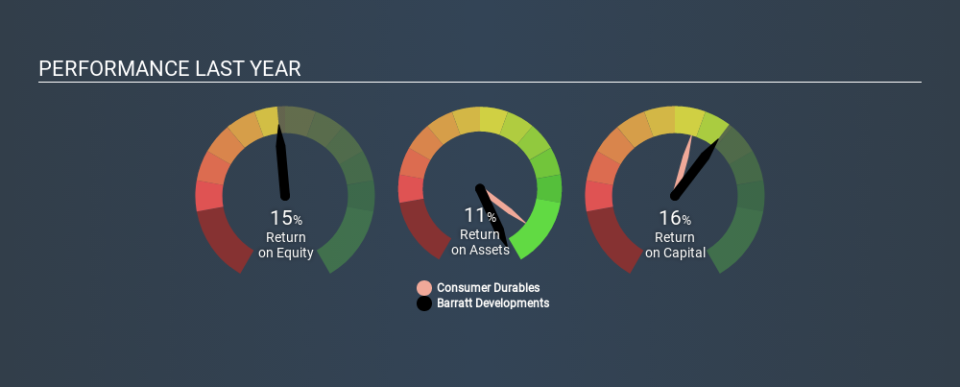Do Barratt Developments PLC’s (LON:BDEV) Returns On Capital Employed Make The Cut?

Today we'll evaluate Barratt Developments PLC (LON:BDEV) to determine whether it could have potential as an investment idea. Specifically, we'll consider its Return On Capital Employed (ROCE), since that will give us an insight into how efficiently the business can generate profits from the capital it requires.
Firstly, we'll go over how we calculate ROCE. Then we'll compare its ROCE to similar companies. Finally, we'll look at how its current liabilities affect its ROCE.
What is Return On Capital Employed (ROCE)?
ROCE is a measure of a company's yearly pre-tax profit (its return), relative to the capital employed in the business. In general, businesses with a higher ROCE are usually better quality. In brief, it is a useful tool, but it is not without drawbacks. Author Edwin Whiting says to be careful when comparing the ROCE of different businesses, since 'No two businesses are exactly alike.
How Do You Calculate Return On Capital Employed?
Analysts use this formula to calculate return on capital employed:
Return on Capital Employed = Earnings Before Interest and Tax (EBIT) ÷ (Total Assets - Current Liabilities)
Or for Barratt Developments:
0.16 = UK£907m ÷ (UK£7.2b - UK£1.7b) (Based on the trailing twelve months to June 2019.)
Therefore, Barratt Developments has an ROCE of 16%.
View our latest analysis for Barratt Developments
Does Barratt Developments Have A Good ROCE?
ROCE is commonly used for comparing the performance of similar businesses. We can see Barratt Developments's ROCE is around the 16% average reported by the Consumer Durables industry. Regardless of where Barratt Developments sits next to its industry, its ROCE in absolute terms appears satisfactory, and this company could be worth a closer look.
The image below shows how Barratt Developments's ROCE compares to its industry, and you can click it to see more detail on its past growth.
When considering ROCE, bear in mind that it reflects the past and does not necessarily predict the future. ROCE can be deceptive for cyclical businesses, as returns can look incredible in boom times, and terribly low in downturns. This is because ROCE only looks at one year, instead of considering returns across a whole cycle. What happens in the future is pretty important for investors, so we have prepared a free report on analyst forecasts for Barratt Developments.
How Barratt Developments's Current Liabilities Impact Its ROCE
Current liabilities are short term bills and invoices that need to be paid in 12 months or less. Due to the way the ROCE equation works, having large bills due in the near term can make it look as though a company has less capital employed, and thus a higher ROCE than usual. To check the impact of this, we calculate if a company has high current liabilities relative to its total assets.
Barratt Developments has total assets of UK£7.2b and current liabilities of UK£1.7b. As a result, its current liabilities are equal to approximately 23% of its total assets. A fairly low level of current liabilities is not influencing the ROCE too much.
What We Can Learn From Barratt Developments's ROCE
Overall, Barratt Developments has a decent ROCE and could be worthy of further research. Barratt Developments shapes up well under this analysis, but it is far from the only business delivering excellent numbers . You might also want to check this free collection of companies delivering excellent earnings growth.
I will like Barratt Developments better if I see some big insider buys. While we wait, check out this free list of growing companies with considerable, recent, insider buying.
If you spot an error that warrants correction, please contact the editor at editorial-team@simplywallst.com. This article by Simply Wall St is general in nature. It does not constitute a recommendation to buy or sell any stock, and does not take account of your objectives, or your financial situation. Simply Wall St has no position in the stocks mentioned.
We aim to bring you long-term focused research analysis driven by fundamental data. Note that our analysis may not factor in the latest price-sensitive company announcements or qualitative material. Thank you for reading.



